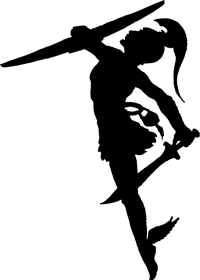by Hari Ravikumar
“Ahimsa doesn’t mean sitting still when someone hits you. It means not intending to hurt anyone,” said the teacher in response to Vinod’s question on the meaning of Ahimsa. The school’s oldest teacher, masterji was a favourite for his willingness to engage with the students on off-the-syllabus topics.
“But Gandhiji said that if someone slaps you, you should show the other cheek,” countered one of the boys.
“Sorry Suleiman, but I disagree with him.”
“So if someone slaps us, should we slap him back masterji?”
“No Sameera. That would be childish. In the first place, you should be alert so as to not get slapped. And if you do get slapped, you can calmly ask the slapper why he did so. Was he hurt because of something you did?”
“But masterji, what if the slapper is stronger than us?”
“How do you decide he is stronger? Just because he is well-built? Remember I told you about Lao-Tze, the Chinese philosopher? He said, ‘Master others and you show force; master yourself and you show strength.’ If you can control your emotions and calmly face someone, you are definitely stronger.”
There was silence for some time in the ninth standard classroom. The teacher continued with his lesson on the Indian independence movement. One of the boys abruptly stood up, looking confused.
“What’s the matter Bimal?”
“Masterji, the British were slapping us and we were showing the other cheek.”
The teacher wiped the sweat on his brow and closed his eyes. After some moments of contemplation he said, “I don’t think so Bimal. We were trying hard to drive sense into their heads, using various means. Different stalwarts used different methods—sama, dana, bheda, danda—but towards the same end. It was that combined effort that brought us independence.”
“What is saamadaanabedanda masterji?” asked Suleiman.
“Hahaha… it is not one word, Suleiman. In ancient Indian books on politics, the great statesmen of yore mention four methods of enforcing law: sama, dana, bheda and danda. Sama means convincing in a gentle way. Dana is appeasement or giving gifts. Bheda is creating division or shaking the unity of the enemy. Danda is punishment.”
“But punishment can be violent, masterji. You just said that we have to be non-violent.”
“Yes, Vinod, you are right. Punishment can be violent and it often is. But you should remember that non-violence cannot exist without violence.”
The boys laughed a bit, but seeing the sombre expression of their teacher, they stopped.
“Seriously, think about it, if there’s no violence, how will we understand non-violence? We’d just call it ‘peace’ or ‘way of life.’ Only humans have this distinction between violence and non-violence, bad and good, wrong and right.”
“Masterji, if a wolf kills a deer, isn’t that violence?”
“That’s as much violence as you eating your daal-chaawal this afternoon.”
“Come on masterji…” cried the boys at the back.
“Boys, we are not going anywhere with this discussion. Let’s get back to the topic.”
The boys protested loudly in a sing-song manner because they knew only too well how much their teacher enjoyed out-of-the-textbook discussions.
“Alright, but not during class. If you stay back for an extra fifteen minutes after class, we’ll go to the garden and talk about this. Agree?”
“Agree!” shouted the boys in unison.
Finding a cosy place under the row of Sal trees in the garden, the teacher and the boys sat down.
“Masterji, let us go one step back. Is violence bad? Is non-violence good?”
“Excellent question Shambu! What do you all think, boys?”
“Gandhiji said violence is bad,” said Rajesh.
“I don’t want to know what Gandhi said – I want to know what you all think.”
“But wasn’t Gandhiji a great man masterji? How come you never agree with him?”
“Of course Gandhi was a great man, Kamal. His ideas on simplicity and self-governance were great. But his ideas on religion, violence and equality were off the mark.”
“So is violence bad and is non-violence good?”
“There is no fixed answer, Dhruv. It depends on how you look at it.”
“I think violence is not good, but violence is not bad if it is like the violence of a wolf killing a deer,” said Arun.
“But Arun, a wolf killing a deer for food is not violence at all. It is a part of nature. Violence is defined only in the world of humans.”
“Then Bhagat Singh’s violence was a good form of violence.”
“Haha… yes Jeevan, you can say that. But do you know that the Britishers called him a terrorist?”
“What?! Shaheed Bhagat Singh a terrorist?” cried Vinod.
“It depends on how you look at it. For the Indians, he was a hero but for the Britishers he was a terrorist.”
“Masterji, we have terrorists in our own village. They keep troubling us. But are they heroes for someone else?” asked Sameera.
“Very good Sameera! You are beginning to look at things from a different perspective. Yes, the ‘terrorists’ are heroes for a few. They have an ideology and they want to fulfil that.”
“But harming innocent people is bad!”
“Yes Kabir, I agree. But keeping with our new technique, let’s look at this from another side. How do you define ‘innocent people’? If a group of people are silently watching the tyranny of a government without protesting or doing something about it, can we call them innocent?”
Saumya said, “In the Mahabharata, Arjuna wanted to be non-violent but Krishna made him fight the war.”
“Excellent observation Saumya! However, I’ll add that Arjuna didn’t ‘want to be non-violent’ but he didn’t want to fight his relatives. Krishna tells him that having come to fight, it would be foolish to run away. There is a time for peace and there is a time for war. A mature person knows when to do what.”
“So that’s the secret then, masterji? Knowing what to do when – non-violence during peace and violence during war?”
“You could say that it’s about doing actions appropriate to the situation. But also remember that there will always be different views – there is no single answer.”
“So we’ve solved the great riddle of violence and non-violence then?”
“Yes Suleiman, and let me tell you that it was no mean feat. You boys have a deep understanding of this topic. I am really happy to have had this discussion today.”
The boys were happy too and they walked back to their homes with much satisfaction. Except the class topper Siyaram, everyone else loved these out-of-the-textbook discussions.
The following day at school, during the sports hour, the boys were in the garden practicing drill with lezims and sticks. The teacher sat at the table in the corner of the classroom. He was engrossed in his work and failed to notice the man who entered the classroom.
After some silent moments, the man perched himself on top of one of the benches spoke in a menacing tone: “What’s this masterji, you work so hard even at this age!”
The teacher looked up and gave out a shriek. Within moments, he collected himself and looked at the man’s face listlessly, ready to accept whatever happened next.
The man looked at this change of expression from fear to calmness and said, “It’s not too late. Shut down this place and retire. All that your students get to read is government propaganda, not the truth!”
The teacher’s face hardened and he looked at the man with unblinking eyes. For months, the Maoists in the area were pushing for the school to be closed.
The man took out a knife and said, “Don’t be stupid master… you’ll just lose your life for nothing. It’s not too difficult for me to drive a knife into that aged heart of yours.”
During the practice break Siyaram went to drink water and happened to see the knife through the window. Petrified upon seeing a man with a knife, he fled. The other boys were intrigued to see him run out of the gate instead of coming back to drill practice. They waited for a minute, unsure whether to wait for Siyaram or not.
The teacher continued sitting at the table, still as a statue with piercing eyes and an obstinate countenance. The man moved closer to him, knife in hand and abuses on tongue.
Meanwhile, one of the other boys chanced upon the sight inside the classroom and called out to the others, “Hey! A terrorist is trying to kill masterji!”
The man had wanted to just scare the teacher, but not kill him as yet, but to gauge his response to their demands. Hearing thunderous footsteps along the corridor, the man panicked and drove the knife into the old teacher’s chest.
The boys rushed into the class with their lezims and sticks. They looked at the man and then looked at the bleeding teacher. Bimal and Saumya ran to masterji to help him, while the rest of the boys beat up the Maoist to death. That evening, Suleiman reflected on the teacher’s words on non-violence from the previous day’s discussion: “There is no single answer.”






